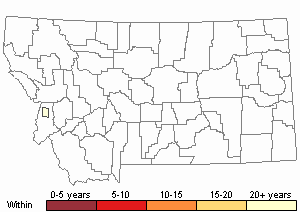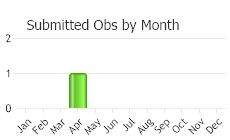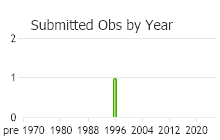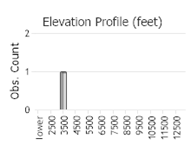View in other NatureServe Network Field Guides
NatureServe
Montana
Utah
Wyoming
Idaho
Wisconsin
British Columbia
South Carolina
Yukon
California
New York
Bicoloured Gemmabryum Moss - Gemmabryum dichotomum
Other Names:
Bicoloured Bryum,
Bryum bicolor, Bryum dichotomum
General Description
Plants: Acrocarpous (Vitt 1988). Growing in open clumps of erect shoots (Crum & Anderson et al. 1981) to somewhat scattered (Flowers 1973), frequently with other moss species (Lawton 1971), green, sometimes with yellow tones (FNA 2014), brown proximally (Lawton 1971). Stems 5-10 mm (occasionally to 20 mm), sometimes bud-like; rhizoids russet to brown (FNA 2014), typically papillose (Lawton 1971).
Leaves: Appressed and overlapping (FNA 2014), barely twisted or curved when dry, spreading a little when wet (Crum & Anderson et al. 1981), egg-shaped, sometimes tending toward lance-shaped, mostly 0.5-1.5 mm in length (FNA 2014), 0.35-0.45 mm in width (Lawton 1971), shallowly cupped, not keeled along the costa; base not extending down stem; margins smooth above, rolled back and downward below, unbordered; apex sometimes tapering to form an acumen; costa extending to the apex or seldom slightly beyond (FNA 2014).
Leaf Cells: Lower laminal cells square to short-quadrangular; middle and upper cells diamond-shaped to 6-sided, elongate, 3-4:1 (FNA 2014), laminal cells lengthened and more slender at the leaf edges, but not creating a border (Lawton 1971).
Phenology
Fruit ripens spring through mid-summer (FNA 2014).
Range Comments
Widespread, with a “temperate bipolar distribution,” growing in the Antarctic and subantarctic tundra in the Southern Hemisphere, and in more temperate areas of the Northern Hemisphere.
North American Range
Canada: BC to SK, ON to NB; USA: northeastern states s to NC and TN, w to IA, MO, AR, KS and CO, and the more western states of AK, WA s and sw to AZ (FNA 2014). Known in Montana from Broadwater and Ravalli Counties (Elliott 2016).
Observations in Montana Natural Heritage Program Database
Number of Observations: 1
(Click on the following maps and charts to see full sized version)
Map Help and Descriptions
Relative Density

Recency



 (Observations spanning multiple months or years are excluded from time charts)
(Observations spanning multiple months or years are excluded from time charts)
Habitat
Dry to damp soil, soil overlying stone (FNA 2014), damp clay soil or sand, frequently beside roads (Lawton 1971) and in other disrupted habitats (Crum & Anderson et al. 1981). Elevation: 0-6560 feet (FNA 2014).
Reproductive Characteristics
Dioicous. Seta 8-20 mm tall (Lawton 1971). Capsule usually 1-3 mm (sometimes a little longer), red with purple tones, drooping, the neck slightly thickened (not clearly swollen) and narrowing suddenly to the seta; cilia transversely ridged and long (FNA 2014).
Specialized vegetative reproduction by bulbils in leaf axils, with 1 or 2 per axil, the bulbils somewhat long and ovoid, bearing wide triangular primordia from just above the base to nearly mid-bulbil (FNA 2014).
Stewardship Responsibility
References
- Literature Cited AboveLegend:
 View Online Publication
View Online Publication Elliott, J.C. and A.K. Pipp. 2018. A Checklist of Montana Mosses (1880-2018). Updated 3 January, 2020. Montana Natural Heritage Program, Helena, Montana. 73 pp.
Elliott, J.C. and A.K. Pipp. 2018. A Checklist of Montana Mosses (1880-2018). Updated 3 January, 2020. Montana Natural Heritage Program, Helena, Montana. 73 pp. Flora of North America Editorial Committee, eds. 2014. Flora of North America North of Mexico. Volume 28. Bryophytes: Mosses, Part 2. Oxford University Press, Inc., NY. xxi + 702 pp.
Flora of North America Editorial Committee, eds. 2014. Flora of North America North of Mexico. Volume 28. Bryophytes: Mosses, Part 2. Oxford University Press, Inc., NY. xxi + 702 pp. Flowers, S. 1973. Mosses: Utah and the West. Brigham Young University, Provo, Utah. 567 p.
Flowers, S. 1973. Mosses: Utah and the West. Brigham Young University, Provo, Utah. 567 p. Lawton, E. 1971. Moss Flora of the Pacific Northwest. Hattori Botanical Laboratory. Japan: Yamabuki-cho, Shinjuku-ku, Tokyo. 362 pages plus appendices.
Lawton, E. 1971. Moss Flora of the Pacific Northwest. Hattori Botanical Laboratory. Japan: Yamabuki-cho, Shinjuku-ku, Tokyo. 362 pages plus appendices. Vitt, D. J. Marsh, and R. Bovey. 1988. Mosses, Lichens & Ferns of Northwest North America. Seattle, WA: University of Washington Press. 296 p.
Vitt, D. J. Marsh, and R. Bovey. 1988. Mosses, Lichens & Ferns of Northwest North America. Seattle, WA: University of Washington Press. 296 p.
- Additional ReferencesLegend:
 View Online Publication
View Online Publication
Do you know of a citation we're missing? Crum, H.A. and L.E. Anderson. 1981. Mosses of Eastern North America. 2 volumes. Columbia University Press, New York. 1328 pp.
Crum, H.A. and L.E. Anderson. 1981. Mosses of Eastern North America. 2 volumes. Columbia University Press, New York. 1328 pp. Elliot, J. C. 1993. Second checklist of Montana mosses. Unpublished report. U.S. Forest Service, Region 1. Missoula, MT. 45 pp.
Elliot, J. C. 1993. Second checklist of Montana mosses. Unpublished report. U.S. Forest Service, Region 1. Missoula, MT. 45 pp. Lawton, E. 1971. Keys for the Identification of the Mosses on the Pacific Northwest. Reprinted from 'Moss Flora of the Pacific Northwest'. Published as Supplement No. 2 of the Journal of the Hattori Botanical Laboratory. Nichinan, Miyazaki, Japan. 66 pp.
Lawton, E. 1971. Keys for the Identification of the Mosses on the Pacific Northwest. Reprinted from 'Moss Flora of the Pacific Northwest'. Published as Supplement No. 2 of the Journal of the Hattori Botanical Laboratory. Nichinan, Miyazaki, Japan. 66 pp. Malcolm, B., N. Malcolm, J. Shevock, and D. Norris. 2009. California Mosses. Nelson, New Zealand: Micro-Optics Press. 430 pp.
Malcolm, B., N. Malcolm, J. Shevock, and D. Norris. 2009. California Mosses. Nelson, New Zealand: Micro-Optics Press. 430 pp. Smith, A.J.E. 1980. The Moss Flora of Britain and Ireland. Cambridge University Press, Cambridge. 705 pp.
Smith, A.J.E. 1980. The Moss Flora of Britain and Ireland. Cambridge University Press, Cambridge. 705 pp.
- Web Search Engines for Articles on "Bicoloured Gemmabryum Moss"





